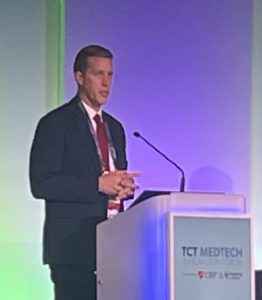
The 2022 Transcatheter Cardiovascular Therapeutics (TCT, 16–19 September, Boston, USA) opened with a day of wide-ranging discussions covering the opportunities for innovation in cardiovascular care. Speakers addressed a spectrum of topics, touching on disparities in the delivery of treatment, and strategies for screening, prevention, and intervention against a backdrop of increasing prevalence of cardiovascular disease among the population.
This formed part of the TCT MedTech Innovation Forum—a new addition to the TCT programme for 2022—described by Cardiovascular Research Foundation (CRF) chief executive officer and president Juan Granada as a platform to spotlight the challenges and opportunities for innovation in cardiovascular care. The pandemic has greatly accelerated digitalisation within healthcare, Granada said in his opening remarks at the session, which may open the door for other changes including treatment of more patients outside of the hospital, expanding access to advanced technologies, and value-based innovation.
A repeated focus running through the day’s session was how new technologies—such as artificial intelligence (AI)-assisted diagnostic tools or remote monitoring—as well as new models of healthcare delivery could be targeted upstream to contribute to the early detection and prevention of cardiovascular disease, as well as guiding treatment.
The session’s opening speaker, Jane Leopold (Brigham and Women’s Hospital, Boston, USA), discussed “precision” cardiovascular medicine, subtitling her presentation “the next frontier in patient care and innovation”. Leopold described this approach as tailoring disease prevention and treatment to take into account differences in people’s genes, environment and lifestyles. Leopold described how computational and technological advances are evolving to create these “precision” interventions.
Following Leopold, Reza Mohebi (Harvard Medical School, Boston, USA), delivered insights from his recent Journal of the American College of Cardiology (JACC) paper in which he and colleagues warned of the potential for substantial increases in cardiovascular disease to contribute to a rising burden on the US healthcare system out to the middle of the century.
An important takeaway from Mohebi’s presentation was that existing efforts to treat coronary artery disease are focussed on the end stage of the disease, while a strategy encompassing screening, prevention and intervention is currently lacking.
Primary disease prevention was a theme picked up by Valentin Fuster (Mount Sinai Health System, New York, USA) in his presentation titled ‘What’s good for the heart is good for the brain’, in which he detailed connections between vascular disease and cognitive dysfunction.
Fuster offered the view that treatment guidelines should have a greater focus on disease prevention in younger patients than directing treatment in older, sick patients.

“We have to change the guideline situation,” he said, commenting that “everything happens before age 40,” referring to the establishment of risk factors early on in life that contribute to disease in later life. “If we begin that early then we create a culture and people are receptive. Then you can talk about [what to do at] age 70, 80, or 90.”
A later session saw the focus shift to emerging models of healthcare delivery, with discussion around decentralised healthcare and value-based cardiovascular care. During the session, representatives from industry discussed the role of emerging technologies in changing the face of diagnosis and treatment of cardiovascular disease. Attendees to the session received updates on several early-stage technologies, including a number underpinned by AI to improve diagnostic efficiency.
Speakers included John Farquhar, chief operating officer of HeartFlow, a developer of a non-invasive technology, using AI algorithms to calculate fractional flow reserve (FFR) in the coronary arteries—HeartFlow FFRct. Farquhar claimed that the coronary artery disease diagnostic pathway is “ripe for disruption” and detailed how the HeartFlow technology is seeking to lead advances in this area.
Another AI-based technology provider—Ultromics—also featured in the programme, with the company’s head of product marketing, Lisa Allen, detailing the EchoGo system, an outcomes-based algorithm trained to detect heart failure. Ade Adesanya, co-founder of Moving Analytics, also outlined his company’s telehealth-based approach to improving uptake in cardiac rehabilitation.

Later, James K Min, introduced Cleerly, an AI-based diagnostic technology, using coronary computed tomography angiography (CCTA) to measure atherosclerosis. Uptake of the technology would mark a shift away from established, symptom-driven assessment approaches based upon indirect surrogate markers of disease, Min commented, advocating a more proactive approach to diagnosis.
The afternoon programme focused on the development of robotic technologies, with three presentations offering different perspectives on the potential use of robotics in cardiovascular care.
Endovascular neurosurgeon Raymond Turner (Prisma Health, Greenville, USA), chief medical officer–Neurovascular at Siemens Healthineers, demonstrated how telerobotics has the potential to extend treatment into hard-to-reach populations. His presentation used the example of stroke interventions into areas that may have poor access to care, explaining that allowing procedures to be performed remotely could improve outcomes in time sensitive cases. In discussion, Turner noted that while the technology has been shown to be effective, current limiting factors for the wider adoption of such platforms centre on legal, ethical and financial issues.
In the following presentation, Ken Charhut, executive chairman of Foldax, explained how his company uses robotic manufacturing procedures in the production of prosthetic heart valves—describing this as a means of “democratising manufacturing”. As well as potential benefits in the precision of the production, using robotics in manufacturing opens up the possibility of being able to develop personalised valves that tailored to the specific dimensions of the patient, Charhut added.
The final session of the day featured a keynote lecture from US Food and Drug Administration (FDA) commissioner Robert M Califf, followed by a panel discussion exploring some of the challenges and opportunities for innovation.












